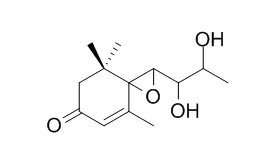| Structure Identification: |
| J Agric Food Chem. 2010 Jan 13;58(1):384-9. | | Floral markers of strawberry tree (Arbutus unedo L.) honey.[Pubmed: 19919097] | Strawberry tree honey, due to its characteristic bitter taste, is one of the most typical Mediterranean honeys, with Sardinia being one of the largest producers. According to specific chemical studies, homogentisic acid was identified as a possible marker of this honey.
METHODS AND RESULTS:
This work, based on HPLC-DAD-MS/MS analysis of strawberry tree (Arbutus unedo L.) honeys, previously selected by sensory evaluation and melissopalynological analysis, showed that, in addition to the above-mentioned acid, there were other high levels of substances useful for the botanical classification of this unifloral honey. Two of these compounds were isolated and identified as (+/-)-2-cis,4-trans-abscisic acid (c,t-ABA) and (+/-)-2-trans,4-trans-abscisic acid (t,t-ABA). A third compound, a new natural product named Unedone, was characterized as an epoxidic derivative of the above-mentioned acids. Structures of c,t-ABA, t,t-ABA, and Unedone were elucidated on the basis of extensive 1D and 2D NMR experiments, as well as HPLC-MS/MS and Q-TOF analysis. In selected honeys the average amounts of c,t-ABA, t,t-ABA, and Unedone were 176.2+/-25.4, 162.3+/-21.1, and 32.9+/-7.1 mg/kg, respectively.
CONCLUSIONS:
Analysis of the A. unedo nectar confirmed the floral origin of these compounds found in the honey.
Abscisic acids were found in other unifloral honeys but not in such high amount and with a constant ratio of about 1:1. For this reason, besides homogentisic acid, these compounds could be used as complementary markers of strawberry tree honey. |
|






 Cell. 2018 Jan 11;172(1-2):249-261.e12. doi: 10.1016/j.cell.2017.12.019.IF=36.216(2019)
Cell. 2018 Jan 11;172(1-2):249-261.e12. doi: 10.1016/j.cell.2017.12.019.IF=36.216(2019) Cell Metab. 2020 Mar 3;31(3):534-548.e5. doi: 10.1016/j.cmet.2020.01.002.IF=22.415(2019)
Cell Metab. 2020 Mar 3;31(3):534-548.e5. doi: 10.1016/j.cmet.2020.01.002.IF=22.415(2019) Mol Cell. 2017 Nov 16;68(4):673-685.e6. doi: 10.1016/j.molcel.2017.10.022.IF=14.548(2019)
Mol Cell. 2017 Nov 16;68(4):673-685.e6. doi: 10.1016/j.molcel.2017.10.022.IF=14.548(2019)